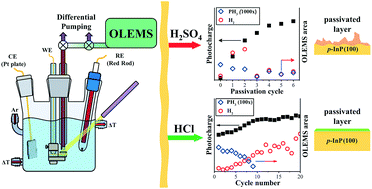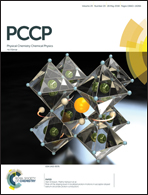On the origin of the photocurrent of electrochemically passivated p-InP(100) photoelectrodes†
Abstract
III–V semiconductors such as InP are highly efficient light absorbers for photoelectrochemical (PEC) water splitting devices. Yet, their cathodic stability is limited due to photocorrosion and the measured photocurrents do not necessarily originate from H2 evolution only. We evaluated the PEC stability and activation of model p-InP(100) photocathodes upon photoelectrochemical passivation (i.e. repeated surface oxidation/reduction). The electrode was subjected to a sequence of linear potential scans with or without intermittent passivation steps (repeated passivation and continuous reduction, respectively). The evolution of H2 and PH3 gases was monitored by online electrochemical mass spectrometry (OLEMS) and the Faradaic efficiencies of these processes were determined. Repeated passivation led to an increase of the photocurrent in 0.5 M H2SO4, while continuous reduction did not affect the photocurrent of p-InP(100). Neither H2 nor PH3 formation increased to the same extent as the photocurrent during the repeated passivation treatment. Surface analysis of the spent electrodes revealed substantial roughening of the electrode surface by repeated passivation, while continuous reduction left the surface unaltered. On the other hand, photocathodic conditioning performed in 0.5 M HCl led to the expected correlation between photocurrent increase and H2 formation. Ultimately, the H2 evolution rates of the photoelectrodes in H2SO4 and HCl are comparable. The much higher photocurrent in H2SO4 is due to competing side-reactions. The results emphasize the need for a detailed evaluation of the Faradaic efficiencies of all the involved processes using a chemical-specific technique like OLEMS. Photo-OLEMS can be beneficial in the study of photoelectrochemical reactions enabling the instantaneous detection of small amounts of reaction by-products.



 Please wait while we load your content...
Please wait while we load your content...